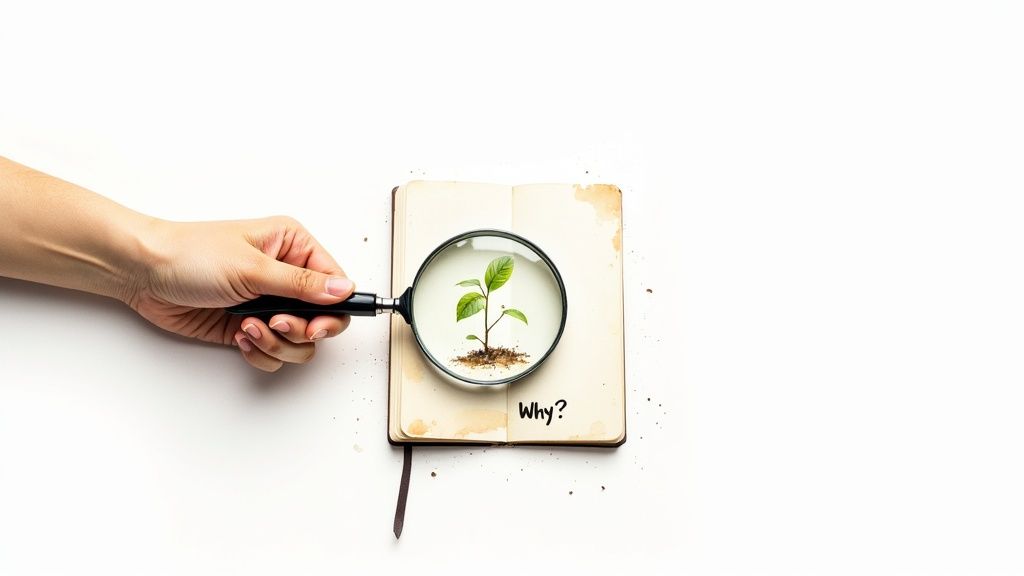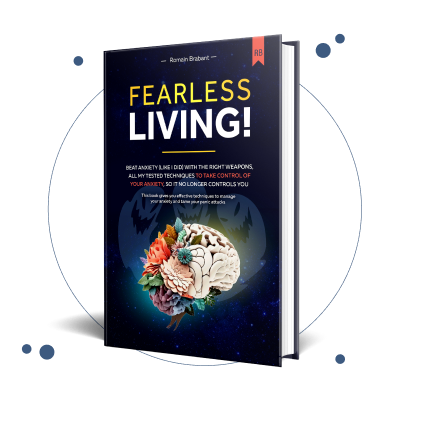
We all have invisible stories we tell ourselves about who we are and what we're capable of. Think of them as internal rules that quietly shape your decisions, often without you even noticing. They dictate what you believe you can—and cannot—achieve. But the most important thing to know is that these rules can be rewritten, offering a clear path to healing from anxiety.
What Are Limiting Beliefs Really?
Imagine wearing sunglasses indoors for so long that you forget the world is actually much brighter. That’s what it's like living with limiting beliefs. Recognizing this is the first step toward taking them off and seeing a hopeful, panic-free life ahead.
They are the deeply ingrained assumptions you’ve accepted as truth, coloring your perception of reality and making you feel stuck or anxious. These aren't just random negative thoughts; they are core convictions that act like an invisible script, running in the background of your mind.

Most of these mental frameworks form in childhood from things we've been told, experiences we've had, or societal pressures we’ve absorbed. Because they feel so fundamental to who we are, we rarely think to question them. They simply are. But once you do, everything can change.
The Impact on Your Well-Being
The real danger of these beliefs is their power to create a self-fulfilling prophecy. If you believe you’re not worthy of success, you might subconsciously sabotage opportunities that could bring you just that.
This isn't just a theory. Research suggests that about 70% of adults struggle with self-doubt, a key symptom of limiting beliefs that directly torpedoes personal growth. You can dive deeper into the research on how these beliefs shape our potential in this in-depth study.
These internal rules are often tangled up with anxiety. They can fuel negative thought loops and what experts call cognitive distortions—patterns of thinking that convince us of things that just aren't true. By learning about common cognitive distortions in our guide, you can start to see how these beliefs warp your reality.
The most freeing realization is that a belief is just a thought you keep thinking. It isn't a permanent truth etched in stone. It’s a pattern that can be understood, challenged, and ultimately, rewritten.
The first step toward change is simply recognizing that these mental sunglasses exist. Once you understand what limiting beliefs are, the door to hope swings open.
It means the anxiety and restrictions you feel aren't a life sentence. They're just signals pointing toward old programming that you have the power to update. This is where you begin the journey of taking off the glasses and finally seeing your life—and yourself—in a much brighter, clearer light, free from the weight of anxiety.
Understanding Where Your Beliefs Come From
Limiting beliefs don't just pop into our heads out of nowhere. They’re learned.
Think of your mind like a garden. Over the years, seeds of belief are planted by the people, places, and experiences around you, often without you even noticing. Those seeds take root and grow into the personal rulebook you live by today. The hopeful news is that you can tend this garden, uprooting what no longer serves you and planting seeds of healing instead.
Many of these foundational beliefs come from our earliest years. Well-meaning advice from parents, a stray comment from a teacher, or cultural messages we absorbed from TV—they can all become internalized truths. A single failure in school might plant the seed of "I'm not good enough," which then gets watered by every setback that follows.
The Voices We Internalize
The process is usually pretty subtle. You probably don’t remember the exact moment a belief formed, but you can definitely see its effects in your daily life. Those external messages eventually become your inner narrator, quietly steering your choices from the background.
Where do these learned beliefs typically come from?
- Childhood Conditioning: Messages from our caregivers shape our fundamental understanding of the world and our place in it. For many of us, this is where the deepest beliefs are formed. Learning about the steps to inner child healing can shed some serious light on these early influences.
- Past Experiences: Big life moments, especially ones involving disappointment or embarrassment, can create powerful beliefs designed to protect you from future pain. Think "It's just safer not to even try."
- Societal and Cultural Norms: The unwritten rules of society about what success, relationships, and self-worth should look like can be a heavy burden. This often leads to beliefs like, "I have to hit certain milestones by a certain age, or I'm failing."
Realizing this can be incredibly freeing. It shifts the focus from "What's wrong with me?" to a shared human experience. Your beliefs aren't personal flaws; they're just stories you've learned along the way.
From Learned Ideas to Liberating Truth
Pinpointing where a belief came from is the first real step toward taking its power away.
When you can trace a thought like "I'm a burden to others" back to its roots—maybe a childhood where you were constantly told not to make a fuss—you start to reclaim your own narrative.
You begin to see that what felt like a fundamental truth about who you are is actually just a hand-me-down idea. This perspective builds the self-compassion you need to start healing.
The goal isn't to blame the past, but to understand how it shaped you. By recognizing that these beliefs were built, you can finally accept that they can be un-built, too. This awareness is the key that unlocks the door to a life without the old programming, offering real hope that you can rewrite your story and live without the constant weight of anxiety and panic.
How Limiting Beliefs Fuel Anxiety
Think of limiting beliefs as the faulty software running your mind’s internal alarm system. When that system is programmed with code like “I have to be perfect” or “I can’t handle surprises,” it becomes hyper-sensitive. It starts seeing threats everywhere, whether they're real or just in your head.
This constant scanning keeps your nervous system on high alert, creating that familiar, humming undercurrent of anxiety. It’s like your body is always braced for a hit because your mind has been taught that danger is lurking around every corner. So, finding real freedom from anxiety isn’t just about treating the symptoms—it’s about rewriting the code and recalibrating the alarm itself.
The Connection Between Beliefs and Panic
Imagine your mind is a security guard who’s been given bad intel. A belief like, “If I make a mistake, everyone will abandon me,” turns every project, conversation, or social gathering into a high-stakes mission. That guard doesn't need to see an actual threat; the mere possibility of one is enough to sound the alarms and trigger a full-blown emergency response.
This is exactly how limiting beliefs create a breeding ground for anxiety and panic:
- They put you in a constant state of threat. Your mind starts filtering neutral, everyday situations through a negative lens, always searching for evidence to confirm its deepest fears.
- They trap you in cycles of overthinking and rumination. You get stuck in mental loops, endlessly replaying past conversations or stressing about future what-ifs. If this sounds familiar, our guide on breaking the cycle of overthinking and anxiety can offer a way out.
- They drain your mental and emotional batteries. Being on high alert 24/7 is completely exhausting. When limiting beliefs are running the show, the persistent anxiety can easily lead to burnout. Learning some practical strategies for avoiding workplace burnout can help protect your energy.
But here’s the hopeful part: your anxiety isn't some random, uncontrollable force. It's actually a logical—though painful—response to a set of rules you learned a long time ago. Once you start addressing these root beliefs, you can begin to teach your mind that it’s safe again.
This shift in perspective is everything. It means you are not broken. Your system is simply doing what it was programmed to do—and you have the power to write new, more compassionate code for it.
Understanding what limiting beliefs are and how they work is the first, most powerful step toward healing. It moves you from feeling like a victim of your anxiety to becoming an active participant in your own recovery. You can learn to question the faulty intel, challenge the old programming, and show your internal alarm system that the world is far safer than it was led to believe. This is how you start living panic-free.
Recognizing Common Limiting Beliefs
Limiting beliefs are sneaky. They often masquerade as practical thoughts or even protective instincts, hiding in the blind spots of our minds. To really get a handle on what are limiting beliefs, you have to see them in action. Once you make these vague ideas concrete, you can start spotting your own patterns—the scripts that are secretly fueling your anxiety.
Most of these beliefs tend to circle back to a few core themes: your self-worth, your capabilities, and your sense of safety in the world. Each one works like a distorted filter, coloring how you see yourself and everything around you.
The infographic below shows just how quickly these internal beliefs can kickstart the anxiety cycle, turning a fleeting thought into a full-blown state of high alert.

As you can see, what starts as a quiet, internal story can directly flip the switch on your body's alarm system. The connection between your thoughts and the physical churn of anxiety is undeniable.
Beliefs About Your Self-Worth
This is probably one of the most common—and painful—categories. Beliefs about your self-worth whisper that you are fundamentally flawed or just don't deserve good things. They're the source of that nagging feeling that you simply aren't "enough."
These beliefs can sound a lot like this:
- "I am not deserving of happiness or love." This thought can make you push away healthy relationships or even sabotage great opportunities. Why? Because deep down, a part of you feels you haven't earned them.
- "I am a burden to others." With this belief running the show, asking for help feels impossible. It can lead to deep social isolation as you constantly try to shrink yourself to avoid being an inconvenience.
- "I need to be perfect to be loved." This is the engine behind perfectionism and a paralyzing fear of failure. Every little task becomes a high-stakes test of your entire worth.
Beliefs About Your Capability
These beliefs take aim at your confidence, attacking your faith in your own skills and intelligence. They create that constant hum of inadequacy, making you second-guess your ability to handle life's curveballs or even chase your own goals. This is the voice of self-doubt that keeps you playing small.
You might recognize a few of these:
- "I'm not smart or talented enough to succeed." This thought alone can stop you from applying for that job, starting that project, or even just sharing your ideas in a meeting.
- "I'll fail if I try anything new." This creates a powerful fear of the unknown, keeping you stuck right in your comfort zone, even when you’re miserable there.
- "Other people are just naturally better than me." This leads to the toxic habit of constant comparison, leaving you with the feeling that you're always falling short, no matter how hard you try.
The most hopeful part of this process is realizing that these thoughts are just stories, not facts. Recognizing a belief is the first step toward rewriting it into a more empowering and truthful narrative.
Seeing these patterns laid out can be a real eye-opener. The table below shows how you can start to shift these thoughts from a place of limitation to one of possibility. It offers a glimpse of what a healthier, more empowering mindset can look like.
From Limiting Beliefs to Empowering Alternatives
Use this table to see how common limiting beliefs can be transformed into healthier, more empowering perspectives.
| Common Limiting Belief | Anxious Thought Pattern | Empowering Alternative |
|---|---|---|
| "I have to be perfect." | "If I make one mistake, it will be a disaster." | "My best effort is enough, and mistakes are opportunities to learn." |
| "The world is a dangerous place." | "Something bad is always about to happen to me." | "I can handle challenges and trust my ability to keep myself safe." |
| "I'm not good enough." | "Everyone will see that I'm a fraud and unqualified." | "I have unique strengths and value to offer, just as I am." |
Recognizing the script is half the battle. Once you can name the story you've been telling yourself, you gain the power to start writing a new one.
Practical Steps to Uncover Your Core Beliefs
Realizing that limiting beliefs are the engine behind your anxiety is a huge leap forward. So, what's next? You need to become a detective of your own mind.
This isn't about judging yourself. It's about bringing a sense of compassionate curiosity to the table to figure out what’s really going on beneath the surface. These simple, gentle techniques will help you shine a light on the beliefs that have been holding you back.

This process puts you back in the driver's seat. You'll move from being controlled by your thoughts to understanding them—and that’s a critical shift on the path to lasting change and a life without panic.
Start with Gentle Observation
The first step is simply to notice. Think of it as thought tracking, or catching your beliefs red-handed.
When you feel that familiar surge of anxiety, that wave of stress, or the sudden urge to procrastinate, just pause. Ask yourself, "What's the story I'm telling myself right now?"
Maybe you notice that every time you think about starting a new project, the thought “I’m going to fail” pops into your head. That’s a belief showing its hand. Just noticing it, without judgment, is a powerfully grounding act.
It's also worth remembering that our environment reinforces these beliefs, often without us even realizing it. Societal norms and what we perceive as "common knowledge" can quietly cement our personal convictions. Research shows that when we're told an idea is widely believed, our own certainty in it can jump significantly. You can see how this plays out on a global scale in this global report on ageism from the WHO.
Use Journaling to Go Deeper
Journaling gives you a private space to explore where your feelings are coming from. It’s a fantastic tool for connecting the dots between a present-day trigger and a deep-seated core belief. You don't need to write a novel; a few focused prompts can unlock some pretty profound insights.
Try using these simple questions to get started:
- When I feel anxious, what’s my first thought about myself? (This gets at beliefs about self-worth.)
- What am I afraid will happen if I try [insert activity]? (This uncovers beliefs about your capabilities and safety.)
- Where might I have learned to think this way? (This helps trace the belief back to its origin story.)
This isn't about digging up the past just to dwell on it. It’s about understanding the old programming so you can start writing new, more empowering code for your mind.
This kind of reflective work is a cornerstone of healing. By gently questioning these internal stories, you can start to untangle the knots of anxiety. For those who like a more structured approach, using shadow work prompts for anxiety can provide a helpful framework for the journey.
By becoming an observer of your own mind, you create the space you need to challenge and, eventually, change the beliefs that no longer serve you. This is how hope becomes a practical, actionable plan for living a calmer, more authentic life.
Your Path to Overcoming Limiting Beliefs
Uncovering your limiting beliefs is a massive first step. Seriously, give yourself credit for that. But this is where the real work—and the real hope—begins. Now you get to dismantle those old, rusty rules and start building new ones that actually serve you.
This isn't about fighting a war with your own mind. Think of it more as a compassionate journey of self-discovery, and thankfully, there’s a clear roadmap you can follow. It’s about more than just slapping on a layer of positive thinking; it’s about using proven methods to fundamentally change your relationship with your thoughts. You’re about to become the editor of your own story, rewriting the parts that have been fueling your anxiety.
The Power of Questioning Everything
The first active step is to get curious and gently—but firmly—challenge your limiting beliefs. When that familiar anxious thought pops up, like “I’m going to fail at this,” don’t just let it run the show. Treat it like a hypothesis, something that needs to be tested before it’s accepted as fact.
This is a core idea in some of the most effective therapeutic approaches out there. Cognitive Behavioral Therapy (CBT), for example, is built on the simple but powerful principle that if we change our thought patterns, we can change our feelings and behaviors. (You can dive deeper into how this works in our guide to understanding CBT for anxiety.) The goal here is to create just enough breathing room between you and the thought to ask, "Is this really 100% true?"
Start by gathering some counter-evidence.
- Look for exceptions: When have you not failed? Dig up some past successes, no matter how small. They’re proof this belief isn't airtight.
- Seek alternative perspectives: If your best friend came to you with this exact same thought, what would you tell them? You’d probably be a lot kinder and more realistic.
- Re-evaluate the source: Think back to where this belief even came from. Is it a dusty old message from childhood that has no business running the life of the capable adult you are today?
A belief is just a thought you keep thinking. Challenging it reminds you that you can choose to think differently. You can introduce a new perspective, even if you don't fully believe it yet.
Creating New and Balanced Beliefs
Here’s a common mistake: trying to flip a deeply ingrained negative thought into an over-the-top positive one. It almost never works. If your brain doesn’t buy it, it will just reject it. The key is to aim for something more balanced, believable, and compassionate.
So, if your limiting belief is, “I mess everything up,” trying to force yourself to believe “I am perfect at everything!” is going to feel like a lie. A much more effective replacement would be something like, “I’m human, so I make mistakes sometimes. But I learn from them, and I also have a solid track record of getting things right.” See the difference? This new belief is grounded in reality and gives you space to be imperfect.
If you're looking for a more comprehensive guide on this process, you can find some great insights on how to overcome limiting beliefs.
Testing Your New Beliefs in the Real World
This is the final, crucial step: you have to take your new belief out for a test drive. In therapy, these are often called behavioral experiments. They’re small, safe actions that let you gather real-world proof that your new, more balanced perspective is the one that holds up.
Let's say your old belief is “I'm a burden if I ask for help.” Your experiment could be as simple as asking a trusted coworker for their opinion on a small task. When they happily oblige and the world doesn’t end, you’ve just given your brain powerful, undeniable evidence that your new belief is true.
This practical, step-by-step approach is how you rebuild trust in yourself. Each small action chips away at the old, anxious programming and reinforces the new, empowered one. This is how lasting change happens. It's a journey out of the cycle of anxiety and into a life where you feel capable, secure, and free.
Got Questions About Limiting Beliefs?
As you start digging into the idea of limiting beliefs, it’s only natural for questions to bubble up. This whole process is a journey of self-discovery, and getting clear, supportive answers can make a world of difference. It helps reinforce that a life free from the grip of panic really is possible.
How Long Does It Take to Change a Belief?
Let’s be real: changing a belief that’s been with you for years isn't an overnight fix. It’s more like building a new habit of thought.
Imagine you're trying to create a new path in a dense forest. The old trail—your limiting belief—is well-worn and easy to slip back onto. But with consistent effort, the new, more empowering path starts to become clearer and, eventually, feels more natural to take.
There's no magic timeline here; everyone's journey looks a little different. The key is consistent, compassionate practice. Each time you gently question an old thought or choose a more balanced perspective, you're strengthening that new neural pathway.
What If I Can't Find an Empowering Belief That Feels True?
This is a huge—and very common—hurdle. Forcing yourself to swallow an overly positive statement that your gut knows is fake will only make you feel worse.
If your core belief is "I'm not good enough," jumping straight to "I am perfect and amazing!" is probably going to feel like a lie. And that’s just discouraging.
Instead, aim for a more believable middle ground. Start with a gentle reframe, something simple like, "I'm open to the idea that I have value," or "I'm a work in progress, and that's okay."
The goal isn't to force positivity. It’s about introducing a kinder, more realistic alternative. This small shift creates just enough space for a new, more supportive belief to eventually take root.
This approach isn't just feel-good advice; it's backed by research. Studies show that our specific beliefs can have a measurable impact on our actions. For example, one study on older adults found that their limiting beliefs about chronic pain directly influenced how active they were each day. You can learn more about these kinds of psychological findings.
Ready to turn this understanding into a real action plan? The Anxiety Checklist gives you the structured tools you need to identify, challenge, and rewrite the beliefs fueling your anxiety. With our comprehensive eBook and interactive checklist, you can build a personalized toolkit to manage anxiety and start living a more fearless life. Begin your journey toward lasting change at https://anxietychecklist.com.

